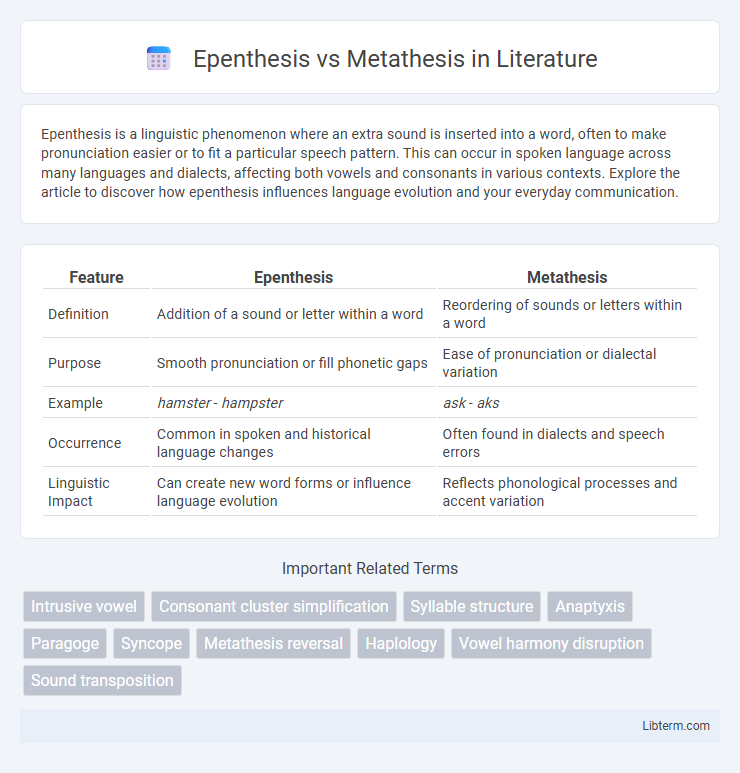Epenthesis is a linguistic phenomenon where an extra sound is inserted into a word, often to make pronunciation easier or to fit a particular speech pattern. This can occur in spoken language across many languages and dialects, affecting both vowels and consonants in various contexts. Explore the article to discover how epenthesis influences language evolution and your everyday communication.
Table of Comparison
| Feature | Epenthesis | Metathesis |
|---|---|---|
| Definition | Addition of a sound or letter within a word | Reordering of sounds or letters within a word |
| Purpose | Smooth pronunciation or fill phonetic gaps | Ease of pronunciation or dialectal variation |
| Example | hamster - hampster | ask - aks |
| Occurrence | Common in spoken and historical language changes | Often found in dialects and speech errors |
| Linguistic Impact | Can create new word forms or influence language evolution | Reflects phonological processes and accent variation |
Introduction to Epenthesis and Metathesis
Epenthesis is the phonological process involving the insertion of an extra sound into a word, often to simplify pronunciation or aid in speech flow, such as adding a vowel in "athlete" pronounced as "ath-e-lete." Metathesis involves the rearrangement of sounds within a word, changing the order of phonemes, like the common historical shift from "ask" to "aks." Both processes serve to modify word forms to enhance ease of articulation and vary across languages and dialects, playing a significant role in linguistic evolution and phonetic adaptation.
Defining Epenthesis: Meaning and Examples
Epenthesis refers to the insertion of an extra sound or letter within a word to facilitate pronunciation or improve phonological structure. Common examples include the insertion of a vowel in the word "athlete" pronounced as "ath-e-lete" or the consonant in "hamster" often pronounced as "hampster." This phonological process contrasts with metathesis, which involves the transposition of sounds rather than their addition.
Understanding Metathesis: Concepts and Illustrations
Metathesis involves the transposition of sounds or syllables within a word, often altering its pronunciation and sometimes its meaning. Common examples include the reversal of sounds in words like "ask" pronounced as "aks" or "bird" as "brid," demonstrating variations in linguistic evolution and dialectical influences. Understanding metathesis provides insights into phonological processes and historical language change patterns, distinguishing it from epenthesis, which primarily involves the insertion of extra sounds.
Linguistic Functions of Epenthesis
Epenthesis serves critical linguistic functions by facilitating syllable structure repair and enhancing phonotactic constraints, often through the insertion of vowels or consonants to break up complex clusters. This process aids in speech clarity and ease of articulation, enabling smoother transitions between sounds. Unlike metathesis, which rearranges existing sounds, epenthesis introduces new segments to maintain prosodic and morphological integrity within languages.
Linguistic Functions of Metathesis
Metathesis, a phonological process involving the transposition of sounds within a word, serves crucial linguistic functions such as easing pronunciation, maintaining rhythmic patterns, and facilitating dialectal variation. Unlike epenthesis, which inserts additional sounds to break clusters, metathesis changes the sequence of existing sounds to optimize speech flow and phonotactic constraints. This process aids language evolution and variety by adapting words to more natural or preferred articulatory patterns within specific linguistic communities.
Key Differences Between Epenthesis and Metathesis
Epenthesis involves the insertion of an extra sound or syllable within a word, altering its pronunciation to ease articulation, as seen in the word "athlete" often pronounced as "ath-e-lete." Metathesis refers to the rearrangement or transposition of sounds or letters in a word, such as the common mispronunciation of "ask" as "aks." Key differences include epenthesis adding sounds to improve phonetic flow, while metathesis changes the order of existing sounds without adding new ones.
Phonological Environments Favoring Epenthesis
Epenthesis commonly occurs in phonological environments where consonant clusters violate the preferred syllable structure, such as complex onset or coda clusters in languages like Japanese or English. It often appears to break up difficult consonant sequences by inserting a vowel, facilitating smoother articulation and maintaining phonotactic constraints. This process is particularly favored in environments involving adjacent obstruents or consonant clusters that are marked or ill-formed within the language's phonological system.
Common Occurrences of Metathesis in World Languages
Metathesis, the transposition of sounds or letters within a word, frequently occurs across various world languages such as Arabic, Greek, and English dialects, exemplified by the shift from "ask" to "aks" in some English vernaculars. This phonological process often arises to facilitate easier pronunciation or to maintain rhythmic and metrical patterns in speech. Unlike epenthesis, which involves the insertion of additional sounds, metathesis reorganizes existing phonemes, reflecting deep-rooted linguistic evolution and regional phonetic variations.
Epenthesis and Metathesis in Language Evolution
Epenthesis, the insertion of an extra sound within a word, plays a significant role in language evolution by facilitating smoother pronunciation and adapting words to phonological patterns. Metathesis, the rearrangement of sounds or syllables, contributes to linguistic change by altering word forms and influencing the development of dialects and languages over time. Both processes drive phonetic adaptation and variation, shaping the trajectory of language transformation throughout history.
Conclusion: Significance in Phonological Processes
Epenthesis and metathesis are crucial phonological processes that enhance speech fluidity and ease of articulation by modifying sound structures within words. Epenthesis involves the insertion of additional sounds to break difficult consonant clusters, improving phonotactic harmony, while metathesis rearranges existing sounds to facilitate smoother transitions between phonemes. Understanding these processes provides insight into language evolution, dialectal variations, and speech development, highlighting their significance in both historical linguistics and contemporary phonological analysis.
Epenthesis Infographic

 libterm.com
libterm.com